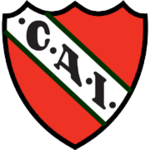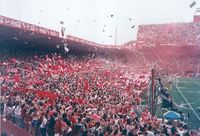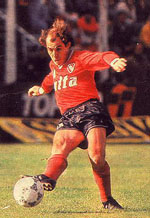Club Atlético Independiente
 |
|||
| Full name | Club Atlético Independiente | ||
|---|---|---|---|
| Nickname(s) | Rojo (Red), Diablo (Devil) Diablo Rojo (Red Devil), Rey de Copas (King of Cups), Orgullo Nacional (National Pride) |
||
| Founded | January 1, 1905 | ||
| Ground | Estadio Libertadores de América Doble Visera, Avellaneda, Argentina (Capacity: 44,000) |
||
| Chairman | Julio Comparada | ||
| Manager | Daniel Garnero | ||
| League | Argentine Primera División | ||
| Clausura 2010 | 4th | ||
|
|||
Club Atlético Independiente (Spanish pronunciation: [ˈkluβ atˈletico indepenˈdjente]) is a popular Argentine sports club best known for its football team, established in 1905. It is based in Avellaneda, Greater Buenos Aires area.
Known as Rojo (Red), Diablo (Devil), Diablo Rojo (Red Devil), Rey de Copas (King of Cups) and Orgullo Nacional (National Pride), Independiente has won 14 Argentine championships, placing them third behind River Plate and Boca Juniors, 7 Copa Libertadores titles, of which an unequalled series of 4 straight wins from 1972 to 1975, and a total of 15 international titles - including 3 Copa Interamericanas, and the 1973 and 1984 Intercontinental Cup. Independiente is one of eight teams to have won CONMEBOL's treble (the others being Boca Juniors, Olimpia, São Paulo, Vélez Sársfield, Cruzeiro, Internacional and LDU Quito).
Independiente's eternal rival Racing has its stadium only a couple of hundred meters from Independiente's [1]. These 2 clubs form the colourful Avellaneda derby, that divides Avellaneda in two.
Many great Argentine players have worn the red outfit. Daniel Bertoni and Jorge Burruchaga became World Champions in 1978 and 1986 respectively with Argentina, but Independiente fans remember more fondly Ricardo "el Bocha" Bochini, who was a champion in 1986 as well, even though he played only a few minutes in the entire World Cup. An incredibly talented midfield player who played for the club from the early seventies until his retirement in the early nineties, Bochini was less fortunate with a national team dominated at the time by Diego Armando Maradona playing in his position.
Contents |
The stadium
In March 4, 1928, in a match against Peñarol of Uruguay that ended in a draw, Independiente established the first stadium in South America. The stadium would later be known as Doble Visera.
The Estadio Libertadores de América was closed for repairs in 2007, and reopened 28 October 2009 in a league match against Colón, which Independiente won 3-2. During construction, Independiente played their home games in four different fields.

History
Foundation
In the beginning of the past century, in a Buenos Aires department store, called "A la Ciudad de Londres" ("To the City of London"), a group of employees decided to form a football team and named it "Maipú Banfield". But this formation didn't allow the younger workers to participate. Therefore, the youngsters chose to unite, hiding from their bosses, to find a solution.
On the 4th of August 1904, this group decided to be "independent" from Maipú Banfield, and created a new club. Therefore, on January 1 of 1905, they officially founded Independiente Football Club, but it wasn't until March 25 where Arístides Langone was named as president, Daniel Bevilacqua as secretary, Juan Artau as sub-secretary, Carlos Degiorgi as sub-treasurer, the other founders were Andrés Ferrier, Víctor Camino and José Hermida.
The Early years
Independiente registered to play in the second and third division of the amateur's league in Argentina. In the second division they played regularly, but in the third division they lost against Atlanta 21-1. A few games after that on June 9 of 1907, they would face their eternal rivals for the first time, Racing Club. After what almost everyone thought an easy victory for Racing, Independiente won 3-2. Later, in 1912, the Federation of Argentine Football invited Independiente to participate in the first division of their league, which would later become the official professional first division in Argentina.
From White to Red

Independiente's original shirt was half blue and half white, with blue shorts, but in 1907, when President Arístides Langone saw Nottingham Forest's red outfit, he decided to give Independiente a new look. Langone thought they looked like "red devils", which would later become Independiente's nickname. In 1908, in a match against Bristol of Uruguay (black-white stripes), Independiente wore the red outfit for the first time, having also changed their original name to Club Atlético Independiente. The original outfit is used as the second kit, using even the original logo.
The 20s
Before "La Doble Visera" was constructed in Avellaneda, Independiente had another stadium in La Crucecita that was destroyed in a fire in 1923.
During the 20s Independiente would become champions of the amateur first division league twice: in 1922 and 1926. Manuel Seoane and Raimundo Orsi were part of those teams. Orsi was then transferred, in 1928, to Juventus F.C. and became a legend by being part of the Italian national team which won the World Championship in 1934.
30s to 50s
Independiente won its first professional league in 1938 and then again in 1939. Arsenio Erico was part of this team and the top scorer in 1937 and 1939. Erico would later become the all-time highest goal scorer of Argentina's top division.
During those years Independiente was known for winning by a vast difference. In 1938, Independiente scored 115 goals in 32 matches, and in 1939, they scored 103 goals in 34 matches. This team is considered being the one to score the most in the Argentine first division.
Independiente would then have to wait nine years to become champions again. And it was in 1948, they would become champions during a strike. Therefore, in the final five matches Independiente played with non-professional players and still managed to obtain the championship, but again they would have to wait, and this time much longer to obtain a league's title.
60s to 80s
Independiente started the 60s with a league title, and then another in 1963. At that time, Independiente had more than 45000 members, a remodeled stadium, and kept growing institutionally. But one of Independiente's greatest achievements would be in 1964, by becoming the first Argentine team to win the Copa Libertadores. Independiente repeated the title in 1965.
1967 would see Independiente win the Nacional tournament. This team would be one of the last few teams that used a 2-3-5 formation. The consagratory match would be in the Avellaneda derby nonetheless, against Racing Club. The game was won by Independiente 4-0.
Again, Independiente started a new decade by winning a title (Metropolitano 1970). The 70s would be Independiente's Golden Era by obtaining 12 important titles: Metropolitano 1970, 1971, Nacional 1977, 1978, Copa Libertadores 1972, 1973, 1974, 1975, Intercontinental Cup 1973, and Copa Interamericana 1973, 1974, 1975.

Independiente greatest achievement in the 70s was to win the Copa Libertadores four times in a row. Also, the team would become famous by having the Bochini-Bertoni attacking duo.
But Independiente's most memorable game was the final match of the Nacional of 1977 tournament, even though the match was played in January the 25th of 1978. The final was against Talleres de Cordoba. The first leg was a tie (1-1) at Independiente's stadium and in the final match in Cordoba, the match was tied on one goal apiece, but with only 15 minutes remaining Talleres scored a controversial goal. As a result, Independiente's players protested, but instead the referee gave the red card to three of the players. With only 8 players playing and a few minutes remaining, Independiente tied the game with an incredible goal by Bochini, assisted by Bertoni. Independiente became the champion by the away goal difference rule.
In 1983, Independiente would win another Metropolitano tournament. Then in 1984, they would obtain their seventh Copa Libertadores and became the team with most trophies of the tournament. Independiente would then play against Liverpool F.C. in Tokyo, Japan, for the Intercontinental Cup. The game ended in a victory for Independiente by 1-0, therefore winning the trophy for the second time.
The last important title that Independiente obtained in the 80s, was the 1988-89 season.
90s to present
The 90s started with the retirement of Ricardo Bochini in 1991. A one club man, in his 20 years of professional football from 1972 to 1991 Bochini played only for Independiente (and the national team), and participated in the club's Golden Era, with 8 international titles, and 4 Argentine championships. He played a total of 740 matches and scoring 107 goals.
Independiente would then win the Clausura 1994, the Supercopa 1994 and 1995, and a Recopa 1995. After winning the Recopa, Independiente then claimed 15 international titles.
After a 7 year drought without winning any important title, Independiente became champions of the Apertura 2002. This team, coached by Américo Gallego, had an offensive playstyle designed by Federico Insúa, Daniel Montenegro, Andrés Silvera, among other important Argentine players.
Even though Independiente obtained an Argentine title in 2002, the club is going through hard times. The club has a serious debt that has been accumulating since the 90s. At first, it was said that the debt was more than 50 million dollars, but in February 2006, the Argentine justice established that the debt was around 26 million. With the transfer of Sergio Agüero to Atlético de Madrid for about 23 million euros, Independiente is hoping to pay off the debt. The club is taking its last steps into coming out of receivership.
The 2006-2007 season started with a lot of enthusiasm. With former star Jorge Burruchaga as the team manager, and notable players such as Daniel Montenegro, Germán Denis and Óscar Ustari, it was expected that the team would fight for the titles. The Apertura finished with Independiente in a fourth place, despite a very irregular campaign, which included a home loss against Gimnasia y Esgrima Jujuy in the last match ever played in the historic Libertadores de América Stadium.
The Clausura 2007 tournament was a total catastrophe. Having earned just 8 points in the first 10 matches, manager Burruchaga resigned after a home loss 0-2 against the modest Godoy Cruz de Mendoza. Miguel Ángel Santoro became the interim coach. The team finished unbeaten with him, winning 4 matches and the other 5 resulting in ties. Independiente finished 11th in the tournament, and missed classification to Libertadores and Sudamericana Cups by just 2 points.
Claudio Borghi took over as manager of the team in 2008, despite a good start, Borghi resigned after losing 3 matches in a row he was replaced by Miguel Angel Santoro in his fourth spell as manager of the team. Many players were brought to revert the horrible 2007 campaign. Higher profile players such as Federico Higuaín, Leonel Rios, Emmanuel Centurion, Leandro Depetris, Leonel Nuñez and Dario Gandin were brought but the performance was not as expected. They were eliminated from the Copa Sudamericana in the 1st round and had three consecutive defeats in the 2008 Apertura (Newell's 0-1, 0-2 against Lanus and Huracan 0-1) that finalized the blow that was seeing the team fail to secure a top spot or enter an international competition .
The Reds are led by Americo Gallego, who left the champion with Independiente in Apertura 2002 after Santoro's resignation after a few dates in the Clausura 2009. Under the leadership of Santoro, Independent is positioned at the 18th place of the 2008 Open over Rosario Central and River Plate 19 º 20 º. In summer, the club signed Eduardo Tuzzio and Paraguayan Diego Gavilan.
In Clausura 2009 Independiente had a very poor campaign in finishing 16th which angered a lot of fans.
Hopes are now renewed for the Apertura 2009, due to the signings of talented striker Andrés Silvera, Carlos Matheu, Ignacio Piatti, and other 5 first level players. Coach Americo Gallego reduced the size of the squad, letting go of 17 players including star attacking midfielder Daniel Montenegro. These moves seem to have paid off so far, with Independiente chasing the title midway through the competition.
Honours
Major titles
-
- Winners (7): 1964, 1965, 1972, 1973, 1974, 1975, 1984.
- Runners-up (0): None.
-
- Winners (1): 1995
- Runners-up (1): 1996.
- Supercopa Sudamericana
-
- Winners (2): 1994, 1995.
- Runners-up (1): 1989.
- Primera División Argentina
-
- Winners (14): 1938, 1939, 1948, 1960, 1963, 1967 Nacional, 1970 Metropolitano, 1971 Metropolitano, 1977 Nacional, 1978 Nacional, 1983 Metropolitano, 1988-1989, Clausura 1994, Apertura 2002.
- Runners-up (14): 1932, 1934, 1935, 1937, 1940, 1954, 1964, 1977 Metropolitano, 1982 Metropolitano, 1983 Nacional, 1989-1990, Clausura 1993, Apertura 1996, Clausura 2000.
Minor competitions
- Copa Río de La Plata
-
- Winners (2): 1938, 1939.
- Runners-up (0): None.
- Amateur Era
-
- Winners (2): AAm 1922, AAm 1926.
- Runners-up (2): AAm 1912, AAm 1923.
-
- Winners (2): 1973, 1984.
- Runners-up (4): 1964, 1965, 1972, 1974.
- Interamerican Cup
-
- Winners (3): 1973, 1974, 1975.
- Runners-up (0): None.
Top scorers
The following tables lists the players that have been named top scorers playing for Independiente in Argentine First Division. Independiete has 15 top scorers, 5 in the amateur era and 10 in the professional era.
Amateur Era
The following players from Independiente had earned the individual distinction of been the top scorers of the amateur era of Argentine First Division:[2]
| Tournament | Player | Goals |
|---|---|---|
| 1912 Federación Argentina de Football | 12 | |
| 1922 Asociación Amateurs de Football | 55 | |
| 1924 Asociación Amateurs de Football | 15 | |
| 1926 Asociación Amateurs de Football | 29 | |
| 1929 Asociación Amateurs Argentina de Football | 13 |
Professional Era
The following players from Independiente had earned the individual distinction of been the top scorers of the professional era of Argentine First Division:[5]
| Tournament | Player | Goals |
|---|---|---|
| 1937 Primera División | 47 | |
| 1938 Primera División | 43 | |
| 1939 Primera División | 40 | |
| 1956 Primera División | 17 | |
| 1966 Primera División | 23 | |
| 1967 Nacional | 11 | |
| 1982 Metropolitano | 20 | |
| 1999 Clausura | 17 | |
| 2002 Apertura | 16 | |
| 2007 Apertura | 18 |
Notable players
- To appear in this section a player must have made at least 50 appearances for the club.
|
|
|
see also Category:Independiente footballers
Current squad
Current squad for Club Atlético Independiente as of December 4, 2010 ()
Sources: Official website and Argentine Soccer
|
|
Manager: Antonio Mohamed
(Players ordered by number. These positions are generic and do not contemplate players that play multiple positions or more specific positions.)
References
- ↑ Independiente stadium
- ↑ [1] Historic Statistics from Argentine First Division.
- ↑ With Ricardo Lucarelli, from Sportivo Buenos Aires, who also scored 15 goals.
- ↑ With Juan Bautista Cortesse, from San lorenzo, who also scored 13 goals.
- ↑ [2] GArgentine First Division Top Scorers, by the RSSSF.
- ↑ With Juan Castro, from Rosario Central, who also scored 17 goals.
External links
- Official website (Spanish and English)
- Argentine Football Association AFA (Spanish and English)
- Independiente Statistics at RSSSF
|
|||||||||||||||||